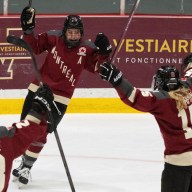Achieving beach hair without the beach is the latest ’do for spring/summer 2008.
Like maintaining the tan without the sun, the beach wave is all about ease and accessibility. Let’s face it, Canadians only have a short window of beach time, but that doesn’t mean we can’t fake it — and look good doing it!
Jan Vandenbroeck, a senior stylist with Exit Hair Salon in Toronto, agrees. He thinks people have tired of the over-processed straight hairstyles that have gained immense popularity over the last few years.
“I think it’s just a logical follow-up to the edginess and the straight hair we’ve been doing. Everyone owns a flat iron these days,” says the 20-year veteran, who’s worked on celebs like supermodel Petra Nemcova. “I find waves and curls way more flattering around the edges, especially for mature women.”
“From shower to style with minimal time,” is how hairstylist Leland Olson, who represents Sunsilk, describes this timeless ’do.
He says the wave has evolved from the late ’80s, early ’90s when crimping was big. Of course, today’s style is more modern — still tousled but less messy.
“A lot of hairstyles, they come in and they go out and then they get recycled again. And it’s really about the timing of the season and who you see wearing the style,” he says, adding Lindsay Lohan, Kate Hudson and Beyonce are all known to sport the beach wave.
With summer around the corner, Olson points out that people will appreciate how this style requires little or no processing — an important factor when you consider the drying impact hair already receives from the sun.
Another thing to remember is it’s not just for females, he says. “I think the beach wave can relate to men as well but in a different way — we’re seeing shorter but still longer and shaggier. Men are using crème product to accentuate the wave and still give it some style.”
So how does one achieve this en vogue look?
For naturally curly hair, Olson suggests starting off with a leave-in conditioner or curl/wave-enhancing product. This will add moisture to the hair and avoid frizz. (For extra enhancement, use a moisture or curl/wave-specific shampoo and condition beforehand). Next, diffuse the hair using a diffuser attachment on your blow dryer.
For straight, fine hair, Olson suggests using a rollerset, curling iron or braiding method.
When rollersetting or curling the hair, use a thermal protecting lotion on the hair first. Next, set the iron on a lower heat for loose curls and use a hairspray afterward.
For a more natural styling method, Olson advises blow-drying the hair until it’s about 80 per cent dry and then braiding it. Let the hair air dry for one hour and then take the braid out.
















